sensor AUDI A5 COUPE 2008 Owner's Guide
[x] Cancel search | Manufacturer: AUDI, Model Year: 2008, Model line: A5 COUPE, Model: AUDI A5 COUPE 2008Pages: 313, PDF Size: 13.86 MB
Page 198 of 313
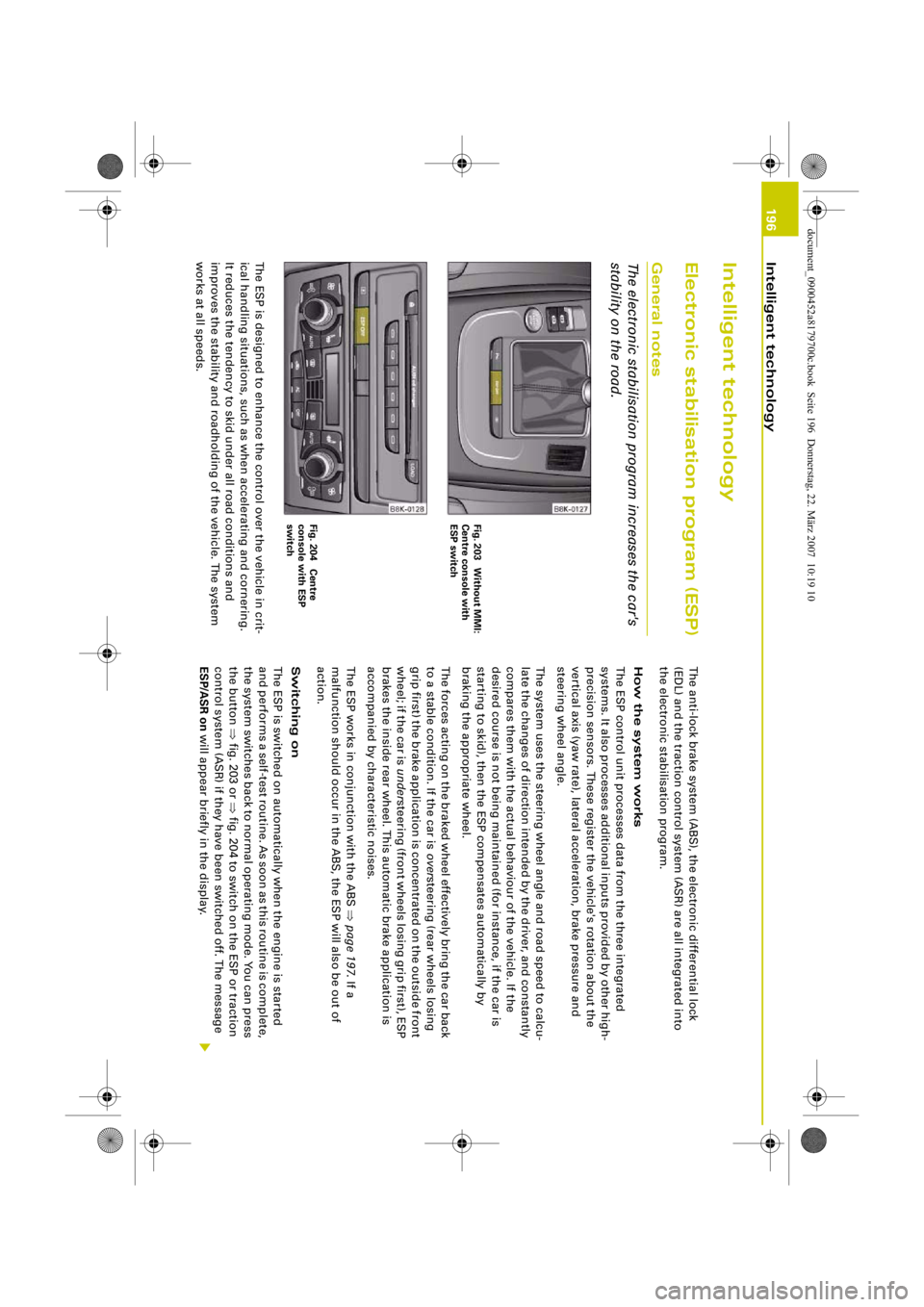
Intelligent technology
196Intelligent technologyElectronic stabilisation program (ESP)General notes
The electronic stabilisation program increases the car's
stability on the road.The ESP is designed to enhance the control over the vehicle in crit-
ical handling situations, such as when accelerating and cornering.
It reduces the tendency to skid under all road conditions and
improves the stability and roadholding of the vehicle. The system
works at all speeds. The anti-lock brake system (ABS),
the electronic differential lock
(EDL) and the traction control system (ASR) are all integrated into
the electronic stabilisation program.
How the system works
The ESP control unit processes data from the three integrated
systems. It also processes addition al inputs provided by other high-
precision sensors. These register the vehicle's rotation about the
vertical axis (yaw rate), lateral acceleration, brake pressure and
steering wheel angle.
The system uses the steering wheel angle and road speed to calcu-
late the changes of direction intended by the driver, and constantly
compares them with the actual be haviour of the vehicle. If the
desired course is not being maintained (for instance, if the car is
starting to skid), then the ESP compensates automatically by
braking the appropriate wheel.
The forces acting on the braked wheel effectively bring the car back
to a stable condition. If the car is oversteering (rear wheels losing
grip first) the brake application is concentrated on the outside front
wheel; if the car is understeering (front wheels losing grip first), ESP
brakes the inside rear wheel. This automatic brake application is
accompanied by characteristic noises.
The ESP works in conj unction with the ABS ⇒page 197 . If a
malfunction should occur in the A BS, the ESP will also be out of
action.
Switching on
The ESP is switched on automatically when the engine is started
and performs a self-test routine. As soon as this routine is complete,
the system switches back to normal operating mode. You can press
the button ⇒fig. 203 or ⇒ fig. 204 to switch on the ESP or traction
control system (ASR) if they have been switched off. The message
ESP/ASR on will appear briefly in the display.
Fig. 203 Without MMI:
Centre console with
ESP switchFig. 204 Centre
console with ESP
switch
document_0900452a8179700c.book Seite 196 Donnerstag, 22. März 2007 10:19 10
ei-4---------4--
-
~
-+
-4
r
....
j
' ,.~
'
' I l
----t-
4-
---,- 1 -
Page 200 of 313
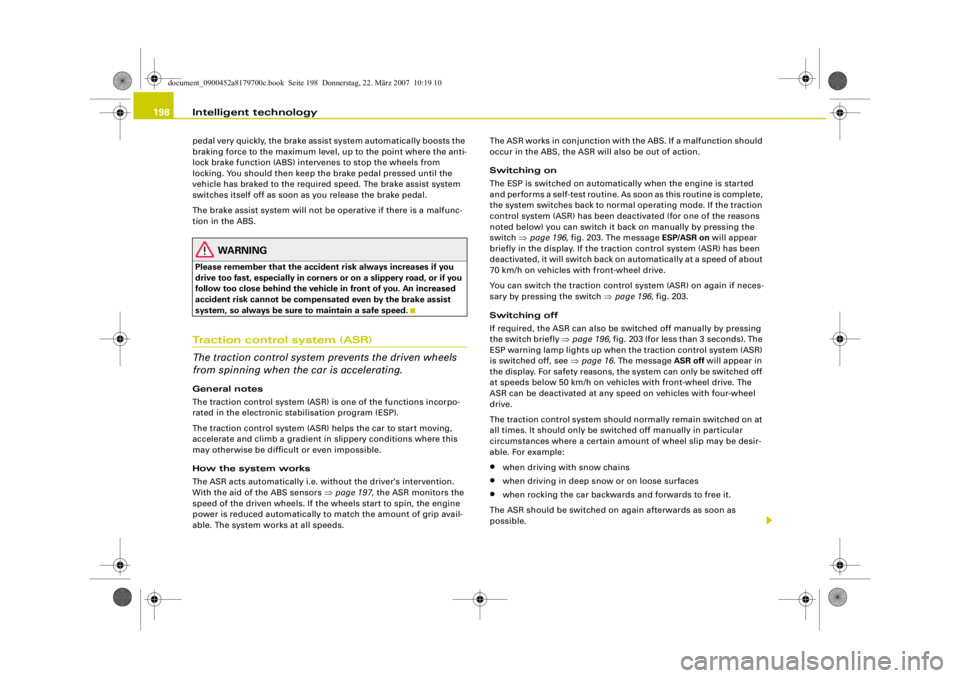
Intelligent technology
198pedal very quickly, the brake assist system automatically boosts the
braking force to the maximum level, up to the point where the anti-
lock brake function (ABS) intervenes to stop the wheels from
locking. You should then keep the brake pedal pressed until the
vehicle has braked to the required speed. The brake assist system
switches itself off as soon as you release the brake pedal.
The brake assist system will not be operative if there is a malfunc-
tion in the ABS.
WARNING
Please remember that the accident risk always increases if you
drive too fast, especially in corners or on a slippery road, or if you
follow too close behind the vehicle in front of you. An increased
accident risk cannot be compensated even by the brake assist
system, so always be sure to maintain a safe speed.Traction control system (ASR)
The traction control system prevents the driven wheels
from spinning when the car is accelerating.General notes
The traction control system (ASR) is one of the functions incorpo-
rated in the electronic stabilisation program (ESP).
The traction control system (ASR) helps the car to start moving,
accelerate and climb a gradient in slippery conditions where this
may otherwise be difficult or even impossible.
How the system works
The ASR acts automatically i.e. without the driver's intervention.
With the aid of the ABS sensors ⇒page 197 , the ASR monitors the
speed of the driven wheels. If the wheels start to spin, the engine
power is reduced automatically to match the amount of grip avail-
able. The system works at all speeds. The ASR works in conjunction with the ABS. If a malfunction should
occur in the ABS, the ASR will also be out of action.
Switching on
The ESP is switched on automatically when the engine is started
and performs a self-test routine. As soon as this routine is complete,
the system switches back to normal operating mode. If the traction
control system (ASR) has been deactivated (for one of the reasons
noted below) you can switch it back on manually by pressing the
switch
⇒page 196, fig. 203. The message ESP/ASR on will appear
briefly in the display. If the traction control system (ASR) has been
deactivated, it will switch back on automatically at a speed of about
70 km/h on vehicles with front-wheel drive.
You can switch the traction control system (ASR) on again if neces-
sary by pressing the switch ⇒page 196, fig. 203.
Switching off
If required, the ASR can also be switched off manually by pressing
the switch briefly ⇒page 196, fig. 203 (for less than 3 seconds). The
ESP warning lamp lights up when the traction control system (ASR)
is switched off, see ⇒page 16 . The message ASR off will appear in
the display. For safety reasons, the system can only be switched off
at speeds below 50 km/h on vehicl es with front-wheel drive. The
ASR can be deactivated at any speed on vehicles with four-wheel
drive.
The traction control system should normally remain switched on at
all times. It should only be switched off manually in particular
circumstances where a certain amount of wheel slip may be desir-
able. For example:
•
when driving with snow chains
•
when driving in deep snow or on loose surfaces
•
when rocking the car backwards and forwards to free it.
The ASR should be switched on again afterwards as soon as
possible.
document_0900452a8179700c.book Seite 198 Donnerstag, 22. März 2007 10:19 10
--4 -
-T
-+
•
+-
Page 201 of 313
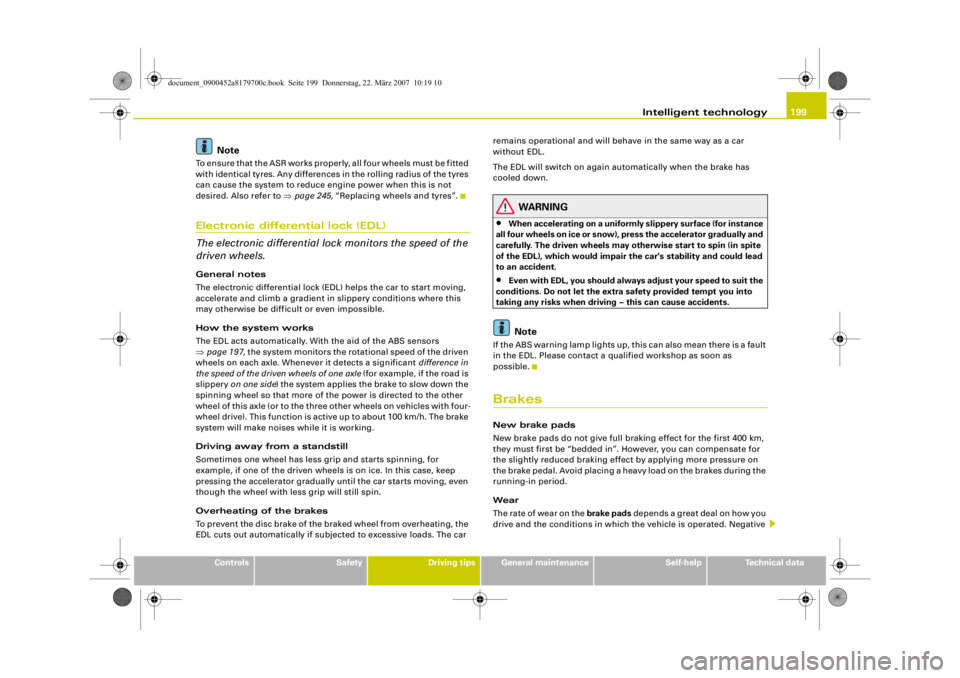
Intelligent technology199
Controls
Safety
Driving tips
General maintenance
Self-help
Technical data
Note
To ensure that the ASR works properly, all four wheels must be fitted
with identical tyres. Any differences in the rolling radius of the tyres
can cause the system to reduce engine power when this is not
desired. Also refer to ⇒page 245, “Replacing wheels and tyres”.Electronic differential lock (EDL)
The electronic differential lock monitors the speed of the
driven wheels.General notes
The electronic differential lock (EDL) helps the car to start moving,
accelerate and climb a gradient in slippery conditions where this
may otherwise be difficult or even impossible.
How the system works
The EDL acts automatically. With the aid of the ABS sensors
⇒page 197 , the system monitors the rotational speed of the driven
wheels on each axle. Whenever it detects a significant difference in
the speed of the driven wheels of one axle (for example, if the road is
slippery on one side ) the system applies the brake to slow down the
spinning wheel so that more of the power is directed to the other
wheel of this axle (or to the three other wheels on vehicles with four-
wheel drive). This function is active up to about 100 km/h. The brake
system will make noises while it is working.
Driving away from a standstill
Sometimes one wheel has less grip and starts spinning, for
example, if one of the driven wheels is on ice. In this case, keep
pressing the accelerator gradually until the car starts moving, even
though the wheel with less grip will still spin.
Overheating of the brakes
To prevent the disc brake of the braked wheel from overheating, the
EDL cuts out automatically if subjected to excessive loads. The car remains operational and will behave in the same way as a car
without EDL.
The EDL will switch on again automatically when the brake has
cooled down.
WARNING
•
When accelerating on a uniforml
y slippery surface (for instance
all four wheels on ice or snow), press the accelerator gradually and
carefully. The driven wheels may ot herwise start to spin (in spite
of the EDL), which would impair th e car's stability and could lead
to an accident.
•
Even with EDL, you should always adjust your speed to suit the
conditions. Do not let the extr a safety provided tempt you into
taking any risks when drivin g – this can cause accidents.Note
If the ABS warning lamp lights up, th is can also mean there is a fault
in the EDL. Please contact a qualified workshop as soon as
possible.BrakesNew brake pads
New brake pads do not give full br aking effect for the first 400 km,
they must first be “bedded in”. However, you can compensate for
the slightly reduced braking effect by applying more pressure on
the brake pedal. Avoid placing a heavy load on the brakes during the
running-in period.
We ar
The rate of wear on the brake pads depends a great deal on how you
drive and the conditions in which the vehicle is operated. Negative
document_0900452a8179700c.book Seite 199 Donnerstag, 22. März 2007 10:19 10
--4 -
-
(I]
T
• &
-+
(I]
•
+-
Page 204 of 313
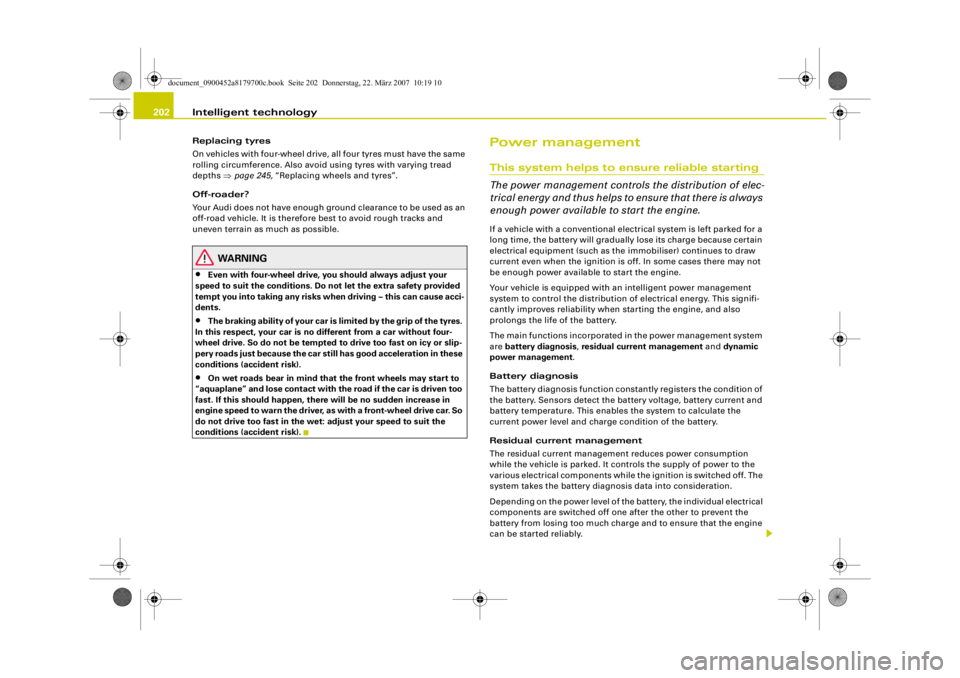
Intelligent technology
202Replacing tyres
On vehicles with four-wheel drive, all four tyres must have the same
rolling circumference. Also avoid using tyres with varying tread
depths ⇒page 245, “Replacing wheels and tyres”.
Off-roader?
Your Audi does not have enough ground clearance to be used as an
off-road vehicle. It is therefore best to avoid rough tracks and
uneven terrain as much as possible.
WARNING
•
Even with four-wheel drive, yo u should always adjust your
speed to suit the conditions. Do not let the extra safety provided
tempt you into taking any risks wh en driving – this can cause acci-
dents.
•
The braking ability of your car is limited by the grip of the tyres.
In this respect, your car is no different from a car without four-
wheel drive. So do not be tempted to drive too fast on icy or slip-
pery roads just because the car still has good acceleration in these
conditions (acc ident risk).
•
On wet roads bear in mind that the front wheels may start to
“aquaplane” and lose contact with the road if the car is driven too
fast. If this should happen, ther e will be no sudden increase in
engine speed to warn the driver, as with a front-wheel drive car. So
do not drive too fast in the wet: adjust your speed to suit the
conditions (acc ident risk).
Power managementThis system helps to ensure reliable starting
The power management controls the distribution of elec-
trical energy and thus helps to ensure that there is always
enough power available to start the engine.If a vehicle with a conventional electrical system is left parked for a
long time, the battery will gradually lose its charge because certain
electrical equipment (such as the immobiliser) continues to draw
current even when the ignition is off. In some cases there may not
be enough power available to start the engine.
Your vehicle is equipped with an intelligent power management
system to control the distribution of electrical energy. This signifi-
cantly improves reliability when starting the engine, and also
prolongs the life of the battery.
The main functions incorporated in the power management system
are battery diagnosis , residual current management and dynamic
power management .
Battery diagnosis
The battery diagnosis function constantly registers the condition of
the battery. Sensors dete ct the battery voltage, battery current and
battery temperature. This enables the system to calculate the
current power level and charge condition of the battery.
Residual current management
The residual current management reduces power consumption
while the vehicle is parked. It controls the supply of power to the
various electrical components while the ignition is switched off. The
system takes the battery diagnosis data into consideration.
Depending on the power level of the battery, the individual electrical
components are switched off one after the other to prevent the
battery from losing too much charge and to ensure that the engine
can be started reliably.
document_0900452a8179700c.book Seite 202 Donnerstag, 22. März 2007 10:19 10
--4 -
-T
-+ +-
•
Page 275 of 313
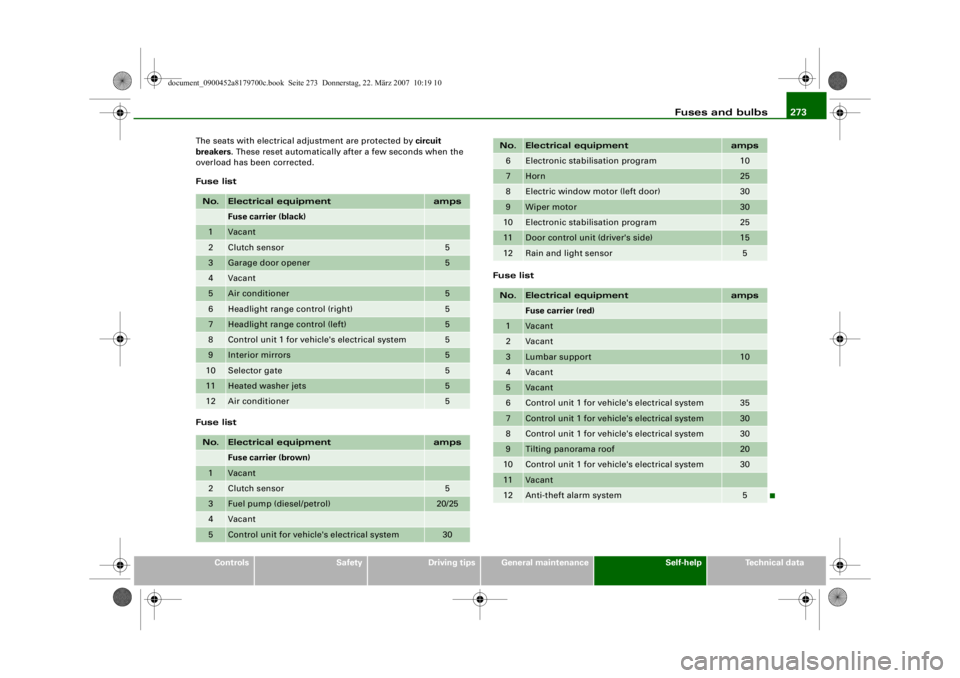
Fuses and bulbs273
Controls
Safety
Driving tips
General maintenance
Self-help
Technical data
The seats with electrical adjustment are protected by circuit
breakers
. These reset automatically after a few seconds when the
overload has been corrected.
Fuse list
Fuse list Fuse list
No.
Electrical equipment
amps
Fuse carrier (black)
1
Vacant
2
Clutch sensor
5
3
Garage door opener
5
4
Vacant
5
Air conditioner
5
6
Headlight range control (right)
5
7
Headlight range control (left)
5
8
Control unit 1 for vehicle's electrical system
5
9
Interior mirrors
5
10
Selector gate
5
11
Heated washer jets
5
12
Air conditioner
5
No.
Electrical equipment
amps
Fuse carrier (brown)
1
Vacant
2
Clutch sensor
5
3
Fuel pump (diesel/petrol)
20/25
4
Vacant
5
Control unit for vehicle's electrical system
30
6
Electronic stab
ilisation program
10
7
Horn
25
8
Electric window motor (left door)
30
9
Wiper motor
30
10
Electronic stabilisation program
25
11
Door control unit (driver's side)
15
12
Rain and light sensor
5
No.
Electrical equipment
amps
Fuse carrier (red)
1
Vacant
2
Vacant
3
Lumbar support
10
4
Vacant
5
Vacant
6
Control unit 1 for vehicle's electrical system
35
7
Control unit 1 for vehicle's electrical system
30
8
Control unit 1 for vehicle's electrical system
30
9
Tilting panorama roof
20
10
Control unit 1 for vehicle's electrical system
30
11
Vacant
12
Anti-theft alarm system
5
No.
Electrical equipment
amps
document_0900452a8179700c.book Seite 273 Donnerstag, 22. März 2007 10:19 10
4----
--4 -
T
-
T
-
- -
- -
-
- -
-+
1111
--
+-
1111
-
-
1111
--
-
- -
- -
-
•
~
-
4-
---r
Page 307 of 313
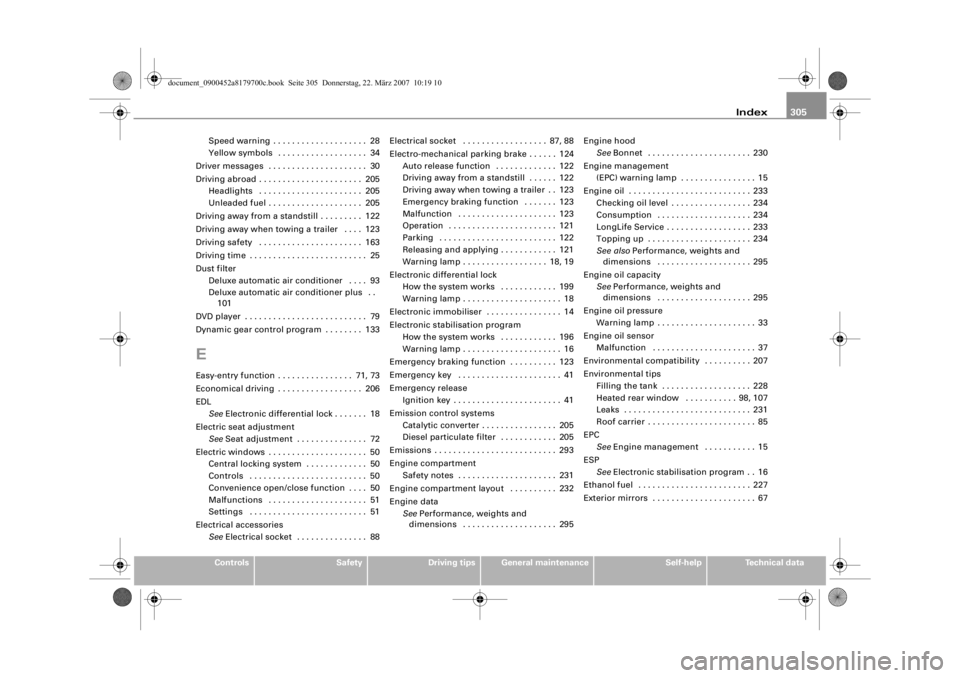
Index305
Controls
Safety
Driving tips
General maintenance
Self-help
Technical data
Speed warning . . . . . . . . . . . . . . . . . . . . 28
Yellow symbols . . . . . . . . . . . . . . . . . . . 34
Driver messages . . . . . . . . . . . . . . . . . . . . . 30
Driving abroad . . . . . . . . . . . . . . . . . . . . . . 205 Headlights . . . . . . . . . . . . . . . . . . . . . . 205
Unleaded fuel . . . . . . . . . . . . . . . . . . . . 205
Driving away from a standstill . . . . . . . . . 122
Driving away when towing a trailer . . . . 123
Driving safety . . . . . . . . . . . . . . . . . . . . . . 163
Driving time . . . . . . . . . . . . . . . . . . . . . . . . . 25
Dust filter Deluxe automatic air conditioner . . . . 93
Deluxe automatic air conditioner plus . . 101
DVD player . . . . . . . . . . . . . . . . . . . . . . . . . . 79
Dynamic gear control program . . . . . . . . 133
EEasy-entry function . . . . . . . . . . . . . . . . 71, 73
Economical driving . . . . . . . . . . . . . . . . . . 206
EDL See Electronic differential lock . . . . . . . 18
Electric seat adjustment See Seat adjustment . . . . . . . . . . . . . . . 72
Electric windows . . . . . . . . . . . . . . . . . . . . . 50 Central locking system . . . . . . . . . . . . . 50
Controls . . . . . . . . . . . . . . . . . . . . . . . . . 50
Convenience open/close function . . . . 50
Malfunctions . . . . . . . . . . . . . . . . . . . . . 51
Settings . . . . . . . . . . . . . . . . . . . . . . . . . 51
Electrical accessories See Electrical socket . . . . . . . . . . . . . . . 88 Electrical socket . . . . . . . . . . . . . . . . . . 87, 88
Electro-mechanical parking brake . . . . . . 124
Auto release function . . . . . . . . . . . . . 122
Driving away from a standstill . . . . . . 122
Driving away when towing a trailer . . 123
Emergency braking function . . . . . . . 123
Malfunction . . . . . . . . . . . . . . . . . . . . . 123
Operation . . . . . . . . . . . . . . . . . . . . . . . 121
Parking . . . . . . . . . . . . . . . . . . . . . . . . . 122
Releasing and applying . . . . . . . . . . . . 121
Warning lamp . . . . . . . . . . . . . . . . . . 18, 19
Electronic differential lock How the system works . . . . . . . . . . . . 199
Warning lamp . . . . . . . . . . . . . . . . . . . . . 18
Electronic immobiliser . . . . . . . . . . . . . . . . 14
Electronic stab ilisation program
How the system works . . . . . . . . . . . . 196
Warning lamp . . . . . . . . . . . . . . . . . . . . . 16
Emergency braking function . . . . . . . . . . 123
Emergency key . . . . . . . . . . . . . . . . . . . . . . 41
Emergency release Ignition key . . . . . . . . . . . . . . . . . . . . . . . 41
Emission control systems Catalytic converter . . . . . . . . . . . . . . . . 205
Diesel particulate filter . . . . . . . . . . . . 205
Emissions . . . . . . . . . . . . . . . . . . . . . . . . . . 293
Engine compartment Safety notes . . . . . . . . . . . . . . . . . . . . . 231
Engine compartment layout . . . . . . . . . . 232
Engine data See Performance, weights and
dimensions . . . . . . . . . . . . . . . . . . . . 295 Engine hood
See Bonnet . . . . . . . . . . . . . . . . . . . . . . 230
Engine management (EPC) warning lamp . . . . . . . . . . . . . . . . 15
Engine oil . . . . . . . . . . . . . . . . . . . . . . . . . . 233 Checking oil level . . . . . . . . . . . . . . . . . 234
Consumption . . . . . . . . . . . . . . . . . . . . 234
LongLife Service . . . . . . . . . . . . . . . . . . 233
Topping up . . . . . . . . . . . . . . . . . . . . . . 234
See also Performance, weights and
dimensions . . . . . . . . . . . . . . . . . . . . 295
Engine oil capacity See Performance, weights and
dimensions . . . . . . . . . . . . . . . . . . . . 295
Engine oil pressure Warning lamp . . . . . . . . . . . . . . . . . . . . . 33
Engine oil sensor Malfunction . . . . . . . . . . . . . . . . . . . . . . 37
Environmental compatibility . . . . . . . . . . 207
Environmental tips Filling the tank . . . . . . . . . . . . . . . . . . . 228
Heated rear window . . . . . . . . . . . 98, 107
Leaks . . . . . . . . . . . . . . . . . . . . . . . . . . . 231
Roof carrier . . . . . . . . . . . . . . . . . . . . . . . 85
EPC See Engine management . . . . . . . . . . . 15
ESP See Electronic stabilis ation program . . 16
Ethanol fuel . . . . . . . . . . . . . . . . . . . . . . . . 227
Exterior mirrors . . . . . . . . . . . . . . . . . . . . . . 67
document_0900452a8179700c.book Seite 305 Donnerstag, 22. März 2007 10:19 10
--4 -
-T
-+ +-
Page 309 of 313

Index307
Controls
Safety
Driving tips
General maintenance
Self-help
Technical data
Interior mirrors
See Mirrors . . . . . . . . . . . . . . . . . . . . 65, 66
Interior monitor . . . . . . . . . . . . . . . . . . . . . . 47
Intermittent wipe . . . . . . . . . . . . . . . . . . . . 62 Rain sensor . . . . . . . . . . . . . . . . . . . . . . . 62
ISOFIX . . . . . . . . . . . . . . . . . . . . . . . . . . . . . 191
JJack . . . . . . . . . . . . . . . . . . . . . . . . . . . 255, 262
Jacking points . . . . . . . . . . . . . . . . . . . . . . 262
Jump-starting . . . . . . . . . . . . . . . . . . . . . . 265KKey-operated switch for front passenger's airbag . . . . . . . . . . . . . . . . . . . . . . . . . 183
Keys . . . . . . . . . . . . . . . . . . . . . . . . . . . . . . . 39 Emergency key . . . . . . . . . . . . . . . . . . . . 41
Replacement keys . . . . . . . . . . . . . . . . . 39
Replacing the battery . . . . . . . . . . . . . . 40
Kick-down multitronic® . . . . . . . . . . . . . . . . . . . . . 133LLeather careAlcantara . . . . . . . . . . . . . . . . . . . . . . . 226
Natural leather . . . . . . . . . . . . . . . . . . . 225
Light sensor . . . . . . . . . . . . . . . . . . . . . . . . . 54
Light sensor defective . . . . . . . . . . . . . . . . 35
Lights . . . . . . . . . . . . . . . . . . . . . . . . . . . . . . 54 Coming home . . . . . . . . . . . . . . . . . . . . . 56
Daytime running lights . . . . . . . . . . . . . 56 Exterior lighting . . . . . . . . . . . . . . . . . . . 56
Front fog lights . . . . . . . . . . . . . . . . . . . 55
Headlight control . . . . . . . . . . . . . . . . . . 54
Leaving home . . . . . . . . . . . . . . . . . . . . . 56
Rear fog lights . . . . . . . . . . . . . . . . . . . . 55
Switching on and off . . . . . . . . . . . . . . . 54
Loading luggage compartment . . . . . . . . 168
Load-through hatch . . . . . . . . . . . . . . . . . . 83
Locking . . . . . . . . . . . . . . . . . . . . . . . . . . . . . 44 Central locking system . . . . . . . . . . . . . 46
Locking and unlocking the vehicle from in- side
Central locking system . . . . . . . . . . . . . 47
Locking doors manually . . . . . . . . . . . . . . . 48
LongLife Service . . . . . . . . . . . . . . . . . . . . 233
Luggage compartment . . . . . . . . . . . . . . . . 77 Extending . . . . . . . . . . . . . . . . . . 80, 81, 82
Fastening rings . . . . . . . . . . . . . . . . . . . 78
Loading . . . . . . . . . . . . . . . . . . . . . . . . . . 77
Load-through hatch . . . . . . . . . . . . . . . . 83
Side storage compartment . . . . . . . . . . 79
Stretch net . . . . . . . . . . . . . . . . . . . . . . . 79
See also Loading luggage compartment
168
Luggage rack See Roof carrier . . . . . . . . . . . . . . . . . . . 84
MMain beam headlights . . . . . . . . . . . . . . . . 59
Indicator lamp . . . . . . . . . . . . . . . . . . . . 17
Make-up mirrors . . . . . . . . . . . . . . . . . . . . . 61 Manual operation
Boot lid . . . . . . . . . . . . . . . . . . . . . . . . . . 49
Fuel tank flap . . . . . . . . . . . . . . . . . . . . 229
Tilting panorama roof . . . . . . . . . . . 52, 53
Manual release Selector lever (multitronic®) . . . . . . . 136
Maximum speed See Performance, weights and
dimensions . . . . . . . . . . . . . . . . . . . . 295
Memory for driver's seat . . . . . . . . . . . . . . . 74 Activating remote control key . . . . . . . 75
Recalling settings . . . . . . . . . . . . . . . . . 74
Storing settings . . . . . . . . . . . . . . . . . . . 74
Messages . . . . . . . . . . . . . . . . . . . . . . . . . . . 30
Mileage recorder . . . . . . . . . . . . . . . . . . . . . 14
Minimising pollution . . . . . . . . . . . . . . . . . 206
Mirrors Anti-dazzle setting . . . . . . . . . . . . . . . . . 66
Automatic anti-dazzle exterior mirrors 68
Automatic anti-dazzle interior mirror . 66
Exterior mirrors . . . . . . . . . . . . . . . . . . . 67
Interior mirror . . . . . . . . . . . . . . . . . . . . . 65
Make-up mirrors . . . . . . . . . . . . . . . . . . . 61
MMI control console, cleaning . . . . . . . . 223
MMI display, cleaning . . . . . . . . . . . . . . . . 223
Mobile phones . . . . . . . . . . . . . . . . . . . . . . 251
Modifications . . . . . . . . . . . . . . . . . . . . . . . 250
multitronic® . . . . . . . . . . . . . . . . . . . . . . . . 130 Driving with multitronic® . . . . . . . . . . 130
Dynamic gear control program . . . . . 133
Kick-down feature . . . . . . . . . . . . . . . . 133
Selector lever lock . . . . . . . . . . . . . . . . 132
Selector lever positions . . . . . . . . . . . . 131
document_0900452a8179700c.book Seite 307 Donnerstag, 22. März 2007 10:19 10
--4 -
-T
-+ +-
Page 310 of 313
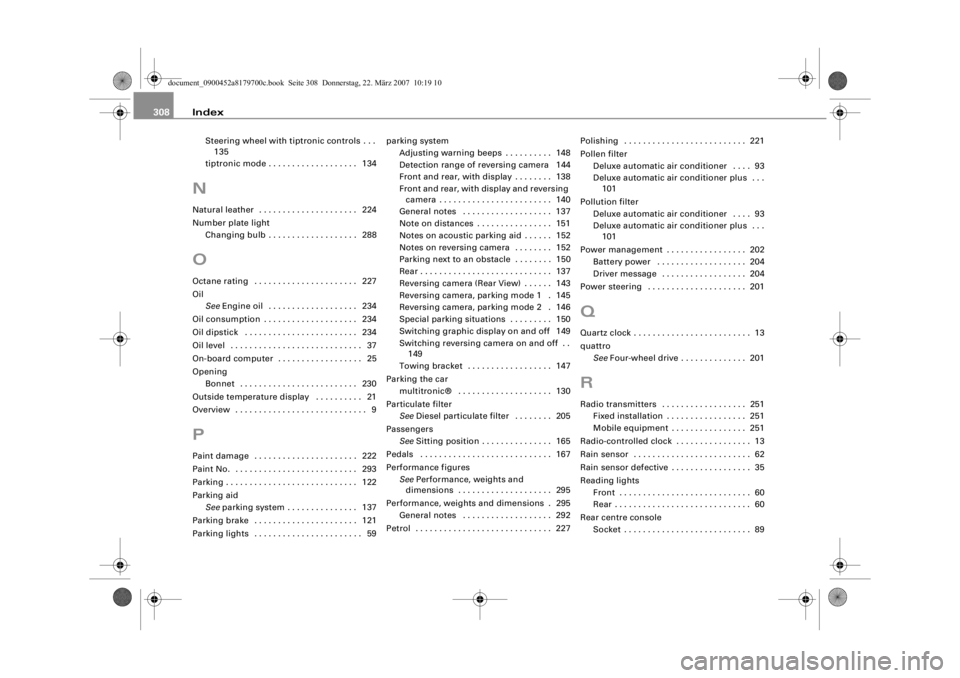
Index
308
Steering wheel with tiptronic controls . . .
135
tiptronic mode . . . . . . . . . . . . . . . . . . . 134
NNatural leather . . . . . . . . . . . . . . . . . . . . . 224
Number plate light Changing bulb . . . . . . . . . . . . . . . . . . . 288OOctane rating . . . . . . . . . . . . . . . . . . . . . . 227
OilSee Engine oil . . . . . . . . . . . . . . . . . . . 234
Oil consumption . . . . . . . . . . . . . . . . . . . . 234
Oil dipstick . . . . . . . . . . . . . . . . . . . . . . . . 234
Oil level . . . . . . . . . . . . . . . . . . . . . . . . . . . . 37
On-board computer . . . . . . . . . . . . . . . . . . 25
Opening Bonnet . . . . . . . . . . . . . . . . . . . . . . . . . 230
Outside temperature display . . . . . . . . . . 21
Overview . . . . . . . . . . . . . . . . . . . . . . . . . . . . 9PPaint damage . . . . . . . . . . . . . . . . . . . . . . 222
Paint No. . . . . . . . . . . . . . . . . . . . . . . . . . . 293
Parking . . . . . . . . . . . . . . . . . . . . . . . . . . . . 122
Parking aid See parking system . . . . . . . . . . . . . . . 137
Parking brake . . . . . . . . . . . . . . . . . . . . . . 121
Parking lights . . . . . . . . . . . . . . . . . . . . . . . 59 parking system
Adjusting warning beeps . . . . . . . . . . 148
Detection range of reversing camera 144
Front and rear, with display . . . . . . . . 138
Front and rear, with display and reversing
camera . . . . . . . . . . . . . . . . . . . . . . . . 140
General notes . . . . . . . . . . . . . . . . . . . 137
Note on distances . . . . . . . . . . . . . . . . 151
Notes on acoustic parking aid . . . . . . 152
Notes on reversing camera . . . . . . . . 152
Parking next to an obstacle . . . . . . . . 150
Rear . . . . . . . . . . . . . . . . . . . . . . . . . . . . 137
Reversing camera (Rear View) . . . . . . 143
Reversing camera, parking mode 1 . 145
Reversing camera, parking mode 2 . 146
Special parking situations . . . . . . . . . 150
Switching graphic display on and off 149
Switching reversing camera on and off . . 149
Towing bracket . . . . . . . . . . . . . . . . . . 147
Parking the car multitronic® . . . . . . . . . . . . . . . . . . . . 130
Particulate filter See Diesel particulate filter . . . . . . . . 205
Passengers See Sitting position . . . . . . . . . . . . . . . 165
Pedals . . . . . . . . . . . . . . . . . . . . . . . . . . . . 167
Performance figures See Performance, weights and
dimensions . . . . . . . . . . . . . . . . . . . . 295
Performance, weights and dimensions . 295 General notes . . . . . . . . . . . . . . . . . . . 292
Petrol . . . . . . . . . . . . . . . . . . . . . . . . . . . . . 227 Polishing . . . . . . . . . . . . . . . . . . . . . . . . . . 221
Pollen filter
Deluxe automatic air conditioner . . . . 93
Deluxe automatic air co nditioner plus . . .
101
Pollution filter Deluxe automatic air conditioner . . . . 93
Deluxe automatic air co nditioner plus . . .
101
Power management . . . . . . . . . . . . . . . . . 202 Battery power . . . . . . . . . . . . . . . . . . . 204
Driver message . . . . . . . . . . . . . . . . . . 204
Power steering . . . . . . . . . . . . . . . . . . . . . 201
QQuartz clock . . . . . . . . . . . . . . . . . . . . . . . . . 13
quattro See Four-wheel drive . . . . . . . . . . . . . . 201RRadio transmitters . . . . . . . . . . . . . . . . . . 251
Fixed installation . . . . . . . . . . . . . . . . . 251
Mobile equipment . . . . . . . . . . . . . . . . 251
Radio-controlled clock . . . . . . . . . . . . . . . . 13
Rain sensor . . . . . . . . . . . . . . . . . . . . . . . . . 62
Rain sensor defective . . . . . . . . . . . . . . . . . 35
Reading lights Front . . . . . . . . . . . . . . . . . . . . . . . . . . . . 60
Rear . . . . . . . . . . . . . . . . . . . . . . . . . . . . . 60
Rear centre console Socket . . . . . . . . . . . . . . . . . . . . . . . . . . . 89
document_0900452a8179700c.book Seite 308 Donnerstag, 22. März 2007 10:19 10
--4 -
-T
-+ +-